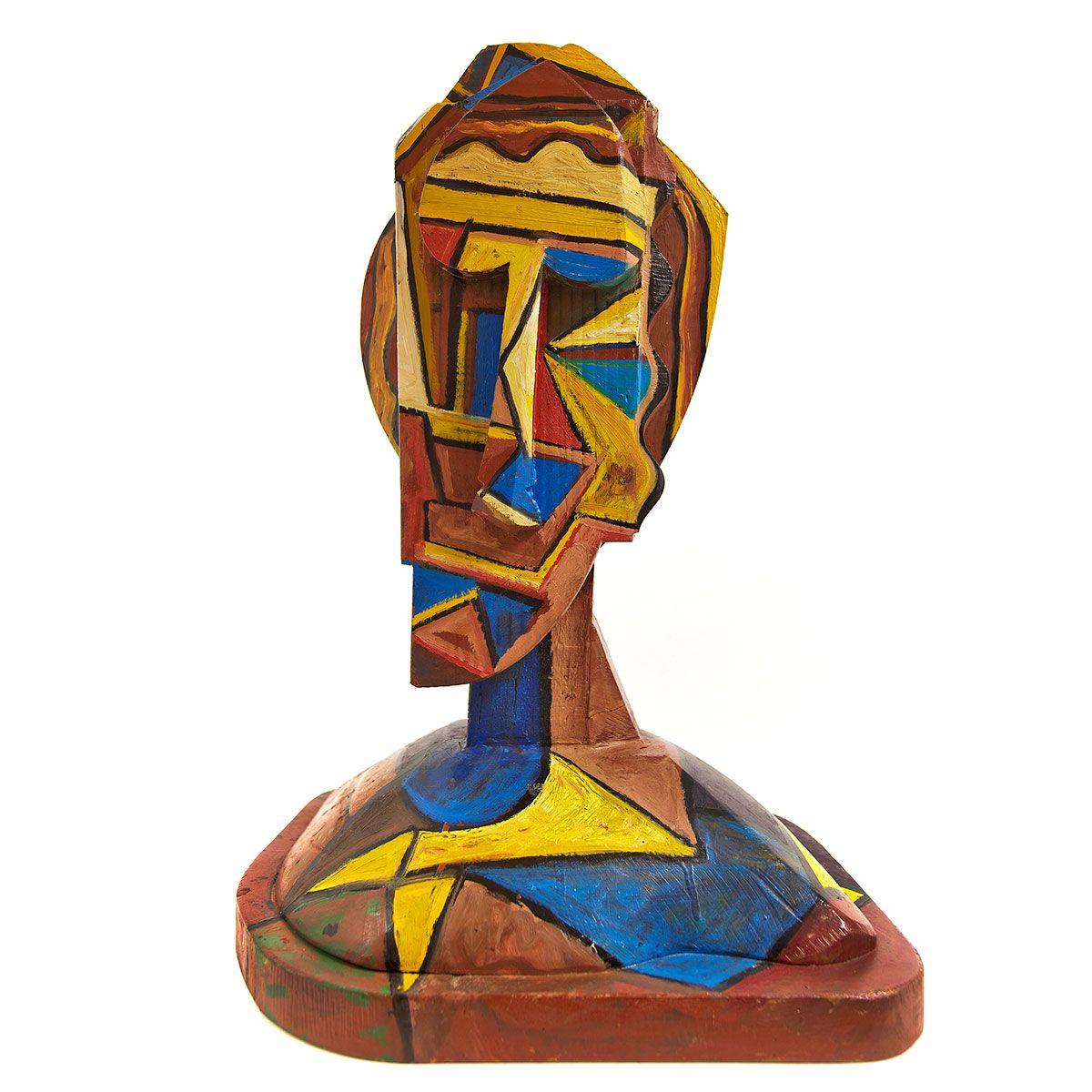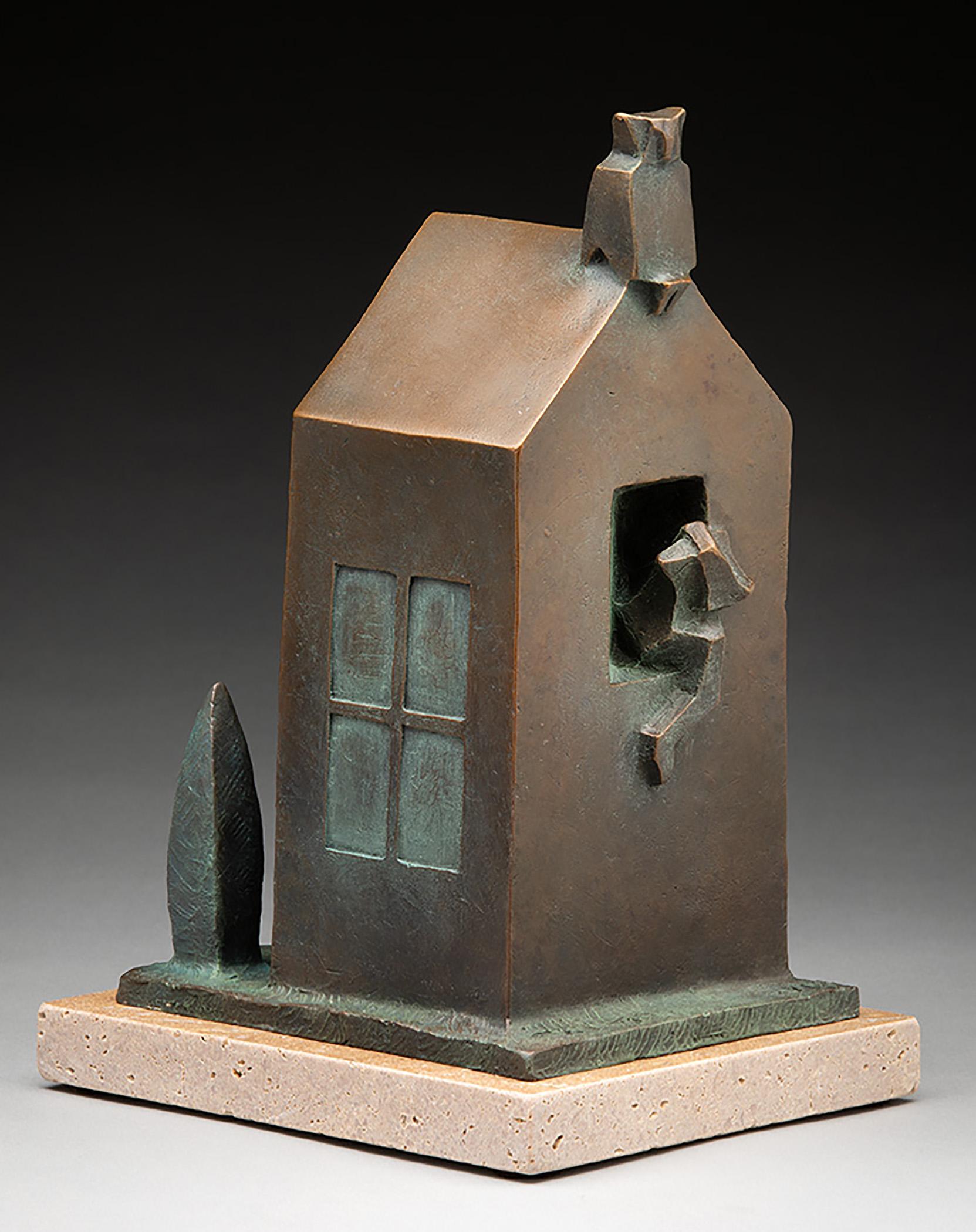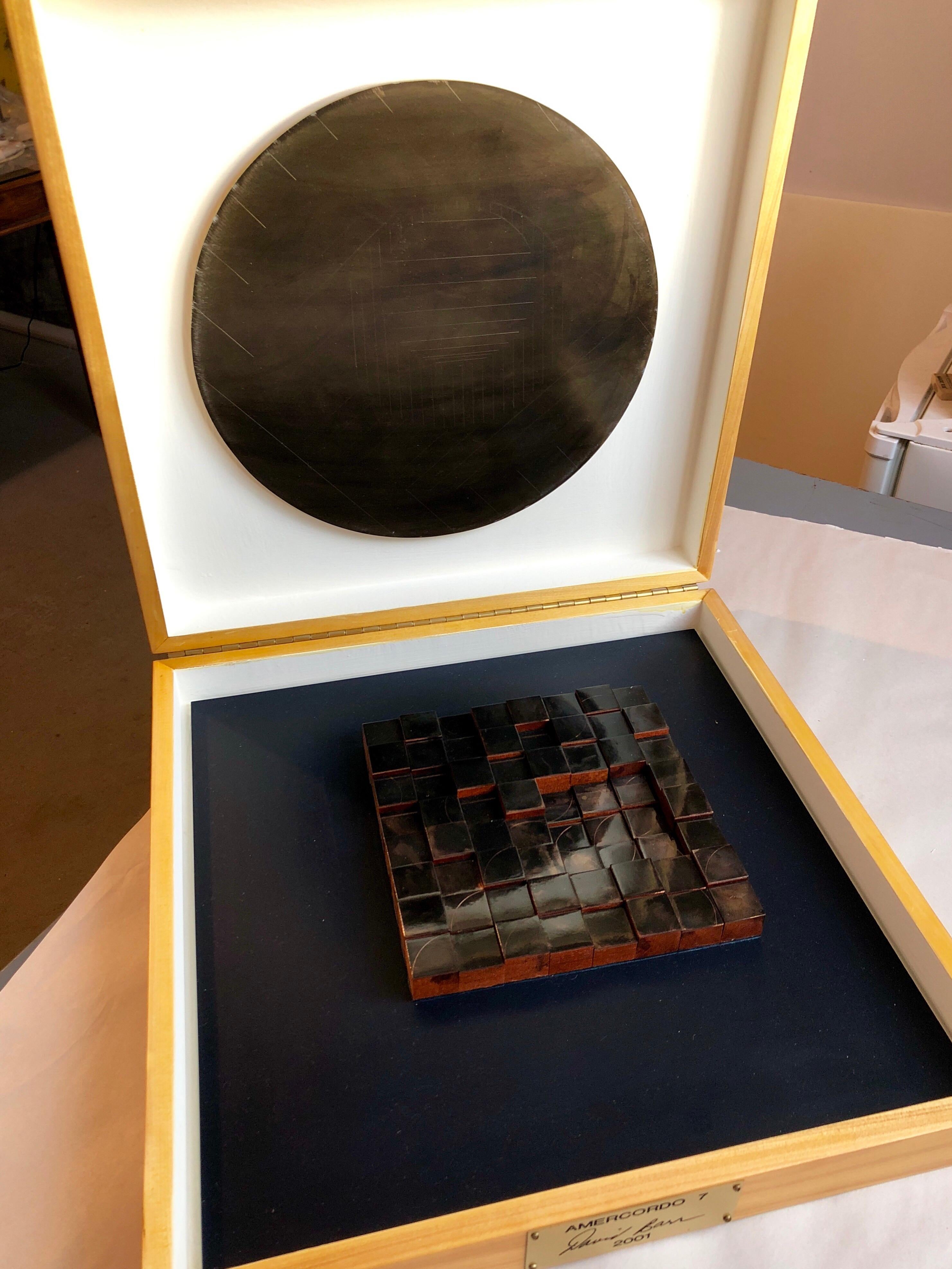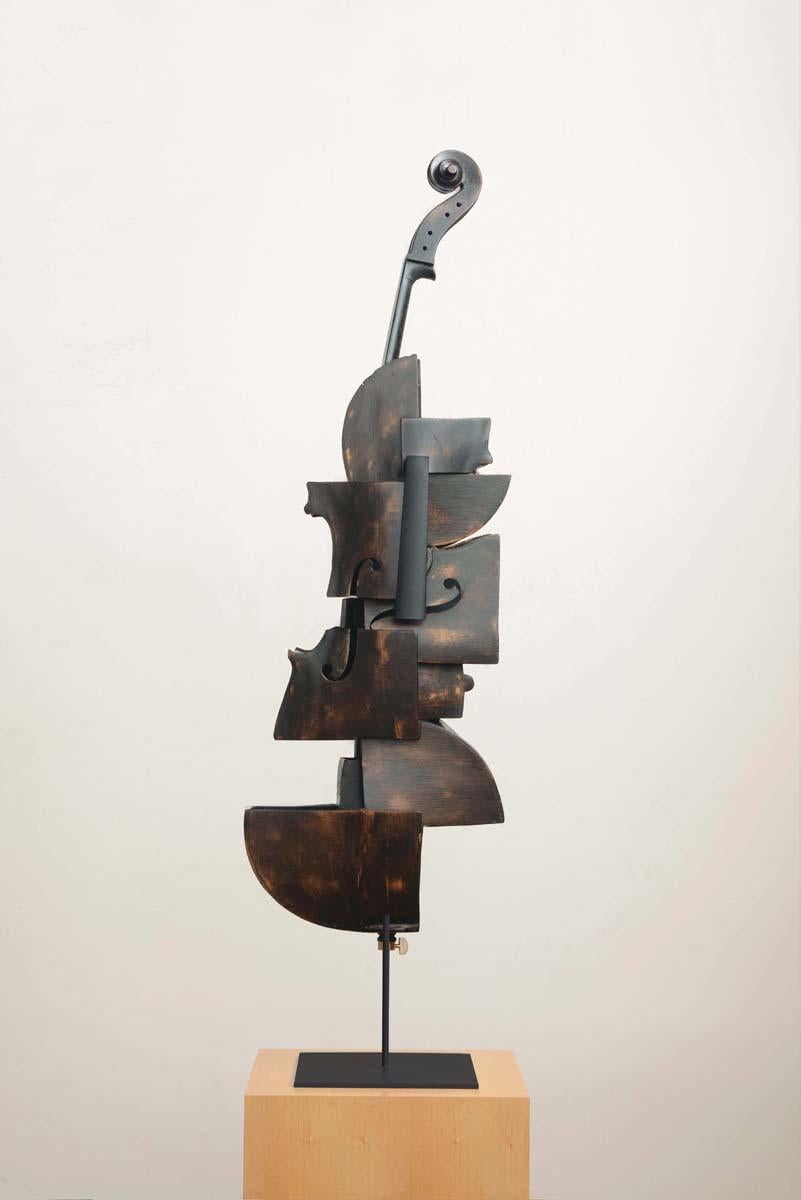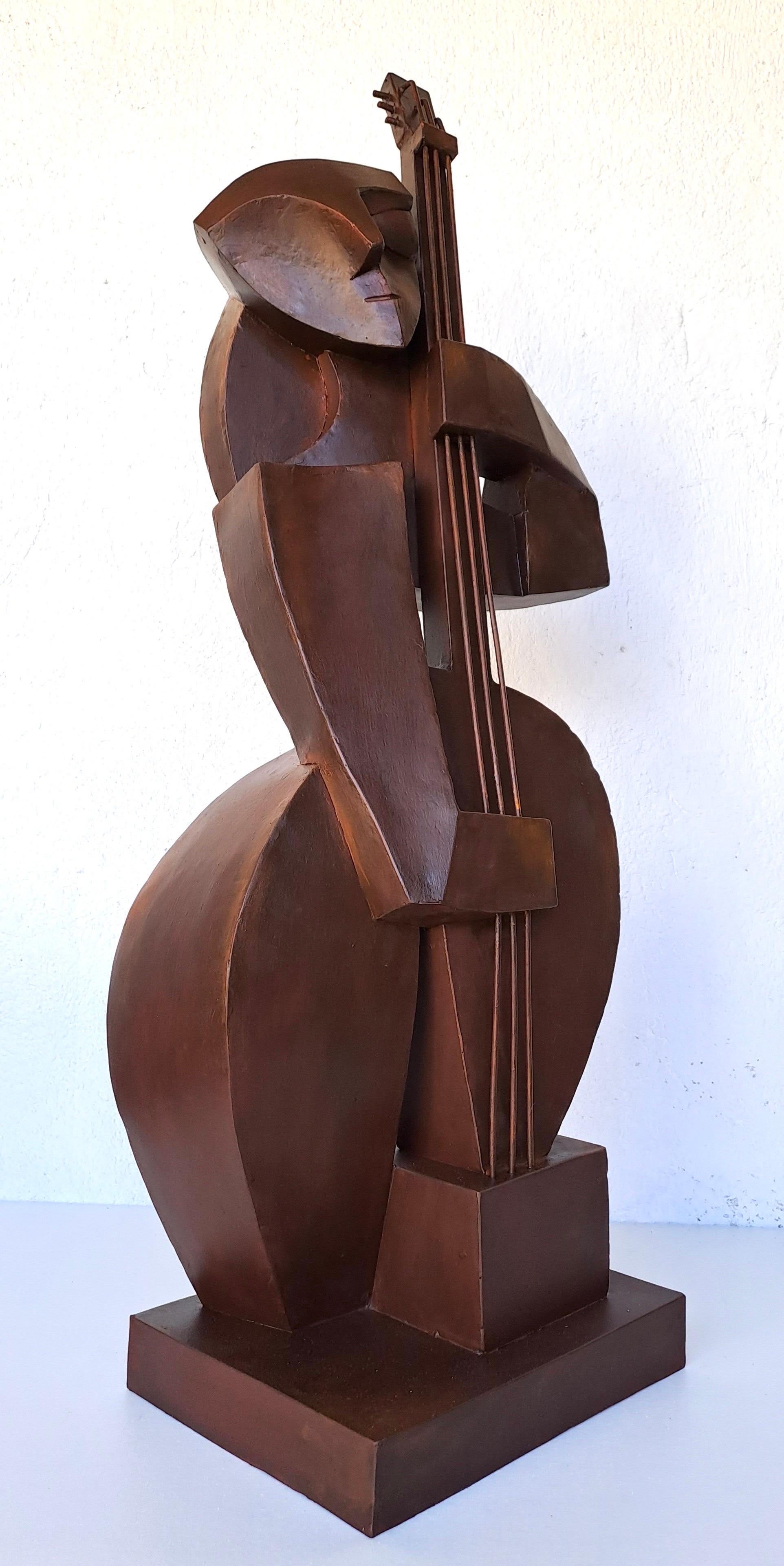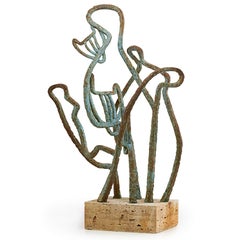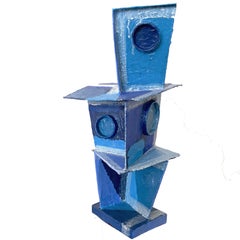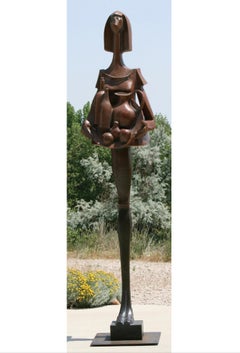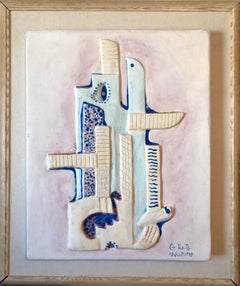
1949 Hungarian Cubism Wall Hanging Relief Sculpture with Enamel Painting Cubist
View Similar Items
Want more images or videos?
Request additional images or videos from the seller
1 of 14
Alfred Reth1949 Hungarian Cubism Wall Hanging Relief Sculpture with Enamel Painting Cubist 1949
1949
About the Item
- Creator:Alfred Reth (1884 - 1966, Hungarian)
- Creation Year:1949
- Dimensions:Height: 39.5 in (100.33 cm)Width: 33.5 in (85.09 cm)
- Medium:
- Movement & Style:
- Period:
- Condition:good. has minor wear commensurate with age but in generally sound condition. wear at joints to frame mounting. please see photos.
- Gallery Location:Surfside, FL
- Reference Number:1stDibs: LU3825597342
Alfred Reth
Born Alfred Roth February 29, 1884 in Budapest and died in September 1966 in Paris was a Hungarian painter, naturalized French, considered one of the main figures of the Avant-garde and the School of Paris. Is the eighth child of a modest Hungarian family. At the end of his schooling, he became a bank employee, as his father wished. From his childhood, Alfréd got to know István Farkas and László Mednyánszky. He befriends the first and the second teaches him to paint. This is where his interest in Buddhism and oriental art was born. In 1903, he binds with the colony of painters of Nagybánya and begins to work under the direction of Károly Ferenczy. In 1905, he left for Paris with József Egry. In France, he worked in the studio of J. E. Blanche in Montmartre. He met the orientalist Jean Buchot through Mednyánszky and developed his interest in Hindu and Khmer art which he discovered at the Musée Guimet. He discovered Cézanne at Ambroise Vollard then at the Salon d'Automne in 1907; he did not join the Fauve group but was part of the cubist movement from 1911. He exhibited 3 paintings at the Salon des Indépendants, hung between those of Matisse and Rouault, and reiterated in 1911: his paintings rubbed shoulders with those of Braque, to whom he would be close later, Léger, Lhote, Metzinger, de Segonzac. He is one of the many so-called painters of the School of Paris. In 1913, he was invited to participate in an exhibition devoted to Cubism in Berlin by the Galerie der Sturm, where he represented French contemporary art with 80 paintings and drawings. Also in 1913, his works were presented in Budapest during a Cubist exhibition. In 1914, with the outbreak of the First World War, he was interned as a citizen of a country enemy of France. The end of the war marked the beginning of the Roaring Twenties, the return of foreign collectors and their large purchases of modern works, an intense, creative and worldly life in a Paris that wanted to compete with Berlin. He is one of the first to embark on the path of abstraction, in the 1920s his paintings are games of lines and planes, curves and strangely figurative. Member of the Abstraction group - creation: Non-figurative art in 1931 with Arp, Georges Valmier, Herbin, Kupka, etc. whose goal is to disseminate abstract art and organize exhibitions, which will be active until 1936. In 1946, after the Second World War, the Salon des Réalités Nouvelles is formed with which he will exhibit. At the end of his life, Réth will always be in the abstract movement, but he will also return to figuration and the collages he had started in 1906, with paper and adding collage of colored printed fabrics. The materials that captivated him then were a major axis in his work until 1960. The year of his death in 1966, it was in Chicago that a retrospective was given to him.
About the Seller
4.9
Platinum Seller
These expertly vetted sellers are 1stDibs' most experienced sellers and are rated highest by our customers.
Established in 1995
1stDibs seller since 2014
1,549 sales on 1stDibs
Typical response time: 1 hour
More From This SellerView All
- Abstract Geometric Cubist Painted Wood Sculpture Head Italian Neo Figurative ArtBy Italo ScangaLocated in Surfside, FLThis painted wood assemblage sculpture by Italo Scanga, epitomizes the characteristics of his oeuvre. Polychrome head portrait bust. This was signed on a brass or bronze plaque but that has gone missing. It is unsigned. I believe there might be a studio stamp on the bottom. Italo Scanga (June 6, 1932 - July 7, 2001), an Italian-born American artist, was known for his sculptures, prints and, paintings, mostly created from found objects. In his youth in Calabria, Italy he worked as a cabinetmaker's apprentice and studies sculpture with a man who carved statues of saints. Italo Scanga was an innovative neo Dada, neo-Expressionist, and neo-Cubist multimedia artist who made assemblage, collage, sculptures of ordinary objects and created prints, glass, and ceramic works. Modern Italian abstract geometric folk art. Scanga's materials included natural objects like branches and seashells, as well as kitsch figurines, castoff musical instruments and decorative trinkets salvaged from flea markets and thrift shops. He combined these ingredients into free-standing assemblages, which he then painted. Although visually ebullient, the results sometimes referred to gruesome episodes from Greek mythology or the lives and deaths of martyred saints. He considered his artistic influences to be sweepingly pan-cultural, from African sculpture to Giorgio de Chirico. He often collaborated with the sculptor Dale Chihuly, who was a close friend. Constructed of wood and glass, found objects or fabric, his ensembles reflect a trio of activities—working, eating, and praying. These activities dominate the lives of those who live close to the land, but they are also activities that are idealized by many who contemplate, romantically, a simpler, bucolic life. Italo graduated from Michigan State University where he befriended fellow artists Richard Merkin and David Pease. He studied under Lindsey Decker who introduces him to welding and sculpture after his initial interest in photography. Also studies with Charles Pollock, the brother of Abstract Expressionist Jackson Pollock. His first teaching job was at University of Wisconsin (through 1964). where he met Harvey Littleton, a fellow instructor. He later moves to Providence, Rhode Island,I to teach at Rhode Island School of Design (RISD). Is colleagues with artists Richard Merkin and Hardu Keck. Starts a correspondence with HC Westermann. Spends summers teaching at Brown University; colleague of Hugh Townley. Moves to State College, PA, and teaches at Pennsylvania State University for one year. Meets artists Juris Ubans, Harry Anderson, Richard Frankel, and Richard Calabro, who remain friends throughout his career. 1967: David Pease helps him get a tenure track position at Tyler School of Art in Philadelphia, PA, . Artists he works closely with include Ernest Silva, Lee Jaffe, Donald Gill, and William Schwedler. Meets graduate student Dale Chihuly while lecturing at RISD and develops a lifelong friendship. 1969: One person exhibition, Baylor Art Gallery, Baylor University, Waco, TX. Works very closely with students Larry Becker and Heidi Nivling (who later run a gallery in Philadelphia, PA), and Harry Anderson. Welcomes many artists into his home including Donald Judd, Dan Flavin, Bruce Nauman (a former student), Vito Acconci, Ree Morton and Rafael Ferrer. 1973: "Saints Glass" at 112 Greene Street Gallery, NYC. Installation at the Institute of Contemporary Art at University of Pennsylvania, Philadelphia, PA. Meets Gordon Matta Clark and contributes to an artist cookbook. Goes to Pilchuck Glass School, Stanwood, WA, founded by Dale Chihuly, as a visiting artist. He continues to work there annually through 2001. Works over the years with Pilchuck artists Richard Royal, Seaver Leslie, Jamie Carpenter, Joey Kirkpatrick, Flora Mace, Robbie Miller, Billy Morris, Buster Simpson, Toots Zynsky, Howard Ben Tre...Category
1980s Cubist Abstract Sculptures
MaterialsWood, Oil
- Modernist Detroit Table Sculpture Wood Collage Box Assemblage Americordo CopperLocated in Surfside, FLCopper and wood box. "Americordo #7" is composed of copper tiles inlaid to the bottom half of the box and on the top rests a patinated etched copper or bronze circle. The box when closed measures to be 17" Sq. x 3.5" H. David Barr (1939-2015) is an American sculptor and painter from Detroit, MI. Known for constructivist sculpture, architecture and surrealist, assemblage box sculpture collage works. Born in 1939, Barr is an internationally known artists and has created many installations in natural settings. Vault took over a year to complete. His sculptures represent mathematics, geography and structurist nature, and otherwise known as "geo-structures." This one is kinetic and can be moved around. Barr is a graduate of Wayne State University and recipient of the WSU Distinguished Alumni Award. Influenced by sculptor Charles Biederman. In 1995 he founded the Michigan Legacy Art Park, and has pieces at the Chrysler World Headquarters, Flint's Bishop Airport, the Detroit Zoo, the State of Michigan Historical Museum and the Meadowbrook Festival Grounds Barr earned a master’s of fine arts degree from Wayne State University and was an associate professor of sculpture at Macomb Community College in Warren for 37 years. He worked on perhaps the largest sculpture in the world, the Four Corners Project, with installations at Greenland, Africa, Irian Jaya (New Guinea) and Easter Island. His sculptures are located all over the state of Michigan, but perhaps his most recognizable is Transcending, a blend of bronze, steel and granite that acknowledges the contributions of Detroit’s laborers and skilled tradespeople. David Barr is the founder of Michigan Legacy Art Park. David’s career as an artist, instructor, author and global thinker has crossed borders around the world, bringing people and ideas together. Over fifty years as a sculptor, David created a body of work that includes hundreds of wall-hanging structurist reliefs, sculptures for public spaces (such as Transcending in Hart Plaza, Detroit done with Sergio De Giusti), works for private collections, massive global projects (such as The Four Corners Project) and Michigan Legacy Art Park. David’s studio was in Detroit for fifteen years until he realized he needed nature as a source of inspiration. In 1977 he bought 4 acres of land in rural Oakland County (now Novi) and in 1979 built his home, a contemporary structure that has become the centerpiece of his own art park. His work is included in the collection of outdoor sculptures at The Dennos Museum Center along with Clement Meadmore, Hanna Stiebel...Category
1990s Cubist Abstract Sculptures
MaterialsMetal, Copper
- Abstract Signed Cubist Bronze Sculpture "Cats" Chicago Bauhaus Woman ModernistLocated in Surfside, FLThis listing is just for the sculpture. (the picture of the ad is for reference and is not included.) Marie Zoe Greene-Mercier was an artist, writer and arts activist who worked in t...Category
1960s Cubist Abstract Sculptures
MaterialsTravertine, Bronze
- 1970's Enamel Metal Vasarely Silkscreen Screenprint Axo Kinetic Op Art SculptureBy Victor VasarelyLocated in Surfside, FLVictor Vasarely (1908-1997) Axo This piece is hand signed and numbered circa 1972-1977 I have seen it described as enamel on steel and enamel on aluminium. it is a serigraph on meta...Category
1970s Op Art Abstract Paintings
MaterialsMetal, Enamel
- Alkyd Enamel Oil Painting Half A Thought Cut Panel Wall Hanging Modern SculptureBy Peter WegnerLocated in Surfside, FLOil-based alkyd enamel on plywood panel with cuts. this is a cut plywood wall relief sculpture with paint on it. This has an architectural quality to it. Peter Wegner (born 1963) is an American artist whose works consist of painting, photograph, collage, prints, artist's books, and large-scale installations Born in Sioux Falls, South Dakota, Peter Wegner earned his BA at Yale University. He works in multiple media, ranging from paintings and photography to large-scale installations and wall works. His pieces are included in major public and private collections worldwide. He currently lives and works in Berkeley, California. A core theme in Wegner's work is color. Professor, author, and critic Eve Meltzer noted in a 2002 review that “color may be the… center” of his entire practice. The artist first began deconstructing the subject in the late 1990s with his "Remarks on Color" series, which used commercial paint chip samples as their starting point. Another theme identified by experts is Wegner's engagement with architecture. For example, in his photography series "Buildings Made of Sky," Wegner reverses urban streetscapes to reveal how skyscrapers shape the open-air spaces between one another into skyscraper-like forms of their own. Wegner has also often pushed the construction of his works in an architectural direction, presenting paintings in the form of leaning columns, complex lattices, and multi-layered scrims. Huldisch noted that “[h]is stacks, grids, and lattice structures reveal both an interest in the forms of Minimalism and a rejection of the stringent doctrine that predicated them." Wegner's early work focuses on everyday artifacts embedded in popular culture, including typography specimens (the basis for the "American Types" series), commercial paint chips (in the "Remarks on Color" series), and security envelopes (in the "Security" series). Wegner produced in 2005 the "Lever Labyrinth," a human-scale maze composed of 2.2 million sheets of stacked paper––all in various shades of green, creating columns of subtly gradating color––constructed inside the Lever House building. In 2008, Wegner executed the major paper installation "GUILLOTINE OF SUNLIGHT, GUILLOTINE OF SHADE" at the San Francisco Museum of Modern Art. The piece consisted of 1.4 millions sheets of die-cut paper in 40 hues, arranged to create two 12’ x 26.5’ x 7" color gradations inside the museum: a wall progressing from blue to yellow in one gallery, and a wall progressing from yellow to red in another. Around this same time, Wegner introduced two new elements into his work: time and neon. He combined both in 2007 to create “THE UNITED STATES OF NOTHING,” which included time-controlled neon signage showing the name, latitude, and longitude of every U.S. city that invokes the concept of nothingness. He has showed at William Griffin Gallery. The gallery has featured solo exhibitions by James Turrell, Richard Long, Robert Rauschenberg, David Lynch, Ed Ruscha, Richard Serra, Tony Smith, Peter Wegner, Greg Colson, Liza Ryan and others. It has presented group exhibitions such as Early California Minimalism, a survey of significant early works by Robert Irwin, John McCracken, and Craig Kauffman; and Wall Installations, with works by Maya Lin, James Turrell, Richard Long, Robert Therrien, Teresita Fernández, Karin Sander, Peter Wegner, and Kira Lynn Harris. It has also presented projects of work by Richard Tuttle, Ana Mendieta...Category
21st Century and Contemporary Conceptual Abstract Paintings
MaterialsEnamel
- Abstract Painted Ceramic Tile Pop Art Painting Italian Neo Figurative PaintingBy Italo ScangaLocated in Surfside, FLThis painted ceramic tile by Italo Scanga, epitomizes the characteristics of his oeuvre. Polychrome and vibrant art from the Memphis Milano era. This is signed with his initials. This is reminiscent of the mid century work of Jean Lurcat and Jean Picart le Doux. Italo Scanga (June 6, 1932 - July 7, 2001), an Italian-born American artist, was known for his sculptures, prints and, paintings, mostly created from found objects. In his youth in Calabria, Italy he worked as a cabinetmaker's apprentice and studies sculpture with a man who carved statues of saints. Italo Scanga was an innovative neo Dada, neo-Expressionist, and neo-Cubist multimedia artist who made assemblage, collage, sculptures of ordinary objects and created prints, glass, and ceramic works. Modern Italian abstract geometric folk art. Scanga's materials included natural objects like branches and seashells, as well as kitsch figurines, castoff musical instruments and decorative trinkets salvaged from flea markets and thrift shops. He combined these ingredients into free-standing assemblages, which he then painted. Although visually ebullient, the results sometimes referred to gruesome episodes from Greek mythology or the lives and deaths of martyred saints. He considered his artistic influences to be sweepingly pan-cultural, from African sculpture to Giorgio de Chirico. He often collaborated with the sculptor Dale Chihuly, who was a close friend. Constructed of wood and glass, found objects or fabric, his ensembles reflect a trio of activities—working, eating, and praying. These activities dominate the lives of those who live close to the land, but they are also activities that are idealized by many who contemplate, romantically, a simpler, bucolic life. Italo graduated from Michigan State University where he befriended fellow artists Richard Merkin and David Pease. He studied under Lindsey Decker who introduces him to welding and sculpture after his initial interest in photography. Also studies with Charles Pollock, the brother of Abstract Expressionist Jackson Pollock. His first teaching job was at University of Wisconsin (through 1964). where he met Harvey Littleton, a fellow instructor. He later moves to Providence, Rhode Island,I to teach at Rhode Island School of Design (RISD). Is colleagues with artists Richard Merkin and Hardu Keck. Starts a correspondence with HC Westermann. Spends summers teaching at Brown University; colleague of Hugh Townley. Moves to State College, PA, and teaches at Pennsylvania State University for one year. Meets artists Juris Ubans, Harry Anderson, Richard Frankel, and Richard Calabro, who remain friends throughout his career. 1967: David Pease helps him get a tenure track position at Tyler School of Art in Philadelphia, PA, . Artists he works closely with include Ernest Silva, Lee Jaffe, Donald Gill, and William Schwedler. Meets graduate student Dale Chihuly while lecturing at RISD and develops a lifelong friendship. 1969: One person exhibition, Baylor Art Gallery, Baylor University, Waco, TX. Works very closely with students Larry Becker and Heidi Nivling (who later run a gallery in Philadelphia, PA), and Harry Anderson. Welcomes many artists into his home including Donald Judd, Dan Flavin, Bruce Nauman (a former student), Vito Acconci, Ree Morton and Rafael Ferrer. 1973: "Saints Glass" at 112 Greene Street Gallery, NYC. Installation at the Institute of Contemporary Art at University of Pennsylvania, Philadelphia, PA. Meets Gordon Matta Clark and contributes to an artist cookbook. Goes to Pilchuck Glass School, Stanwood, WA, founded by Dale Chihuly, as a visiting artist. He continues to work there annually through 2001. Works over the years with Pilchuck artists Richard Royal, Seaver Leslie, Jamie Carpenter, Joey Kirkpatrick, Flora Mace, Robbie Miller, Billy Morris, Buster Simpson, Toots Zynsky, Howard Ben Tre...Category
1980s Neo-Expressionist Abstract Sculptures
MaterialsEnamel
You May Also Like
- 'Blue Tone Tower': Modernist Vibrant Blues Cubist Sculpture by Bill LowBy Bill LowLocated in Hudson, NYCubist style abstract mixed-media sculpture titled 'Blue Tone Tower' was created using various materials including wood, papier-mache, and paint by Bill Low ...Category
Mid-20th Century Cubist Abstract Sculptures
MaterialsWood, Paint, Paper
- Modernist Cubist Sculpture by Bill Low with Weathered Bronze FinishBy Bill LowLocated in Hudson, NYCubist abstract mixed-media sculpture titled 'Horse and Rider' was created using various materials including wood, papier-mache, and paint by Bill Low (Scotl...Category
Mid-20th Century Cubist Abstract Sculptures
MaterialsWood, Paint, Paper
$1,280 Sale Price20% Off - "Sierra" Large Bronze cast sculpture of a woman holding fruit, CubismBy Wayne SalgeLocated in Edgartown, MAThe historic tradition of cast bronze provides a contemporary avenue for the creation of Wayne Salge’s abstracted human and animal figures. Thoroughly modern and distinctly impressio...Category
2010s Cubist Abstract Sculptures
MaterialsBronze
- "Petit masque découpé Montserrat", 20th Century Bronze by Julio GonzálezLocated in Madrid, ESJULIO GONZÁLEZ Spanish, 1876 - 1942 PETIT MASQUE DÉCOUPÉ MONTSERRAT signed "GONZALEZ" 5 of an edition of 9 Cire Perdue "C. VALSUANI" foundry seal bronze...Category
1930s Cubist Abstract Sculptures
MaterialsBronze
- "Cabin Fever 2" Bronze cast mini sculpture of a house with owl, CubismBy Wayne SalgeLocated in Edgartown, MAThe historic tradition of cast bronze provides a contemporary avenue for the creation of Wayne Salge’s abstracted human and animal figures. Thoroughly modern and distinctly impressio...Category
2010s Cubist Abstract Sculptures
MaterialsBronze
- CelloBy Koji TakeiLocated in Santa Monica, CAKoji Takei works reference synthetic cubism in the most literal of senses. In cubist artworks, the objects are broken up, analyzed and re-assembled in abstracted form. These pieces...Category
2010s Cubist Abstract Sculptures
MaterialsMetal
$12,000
